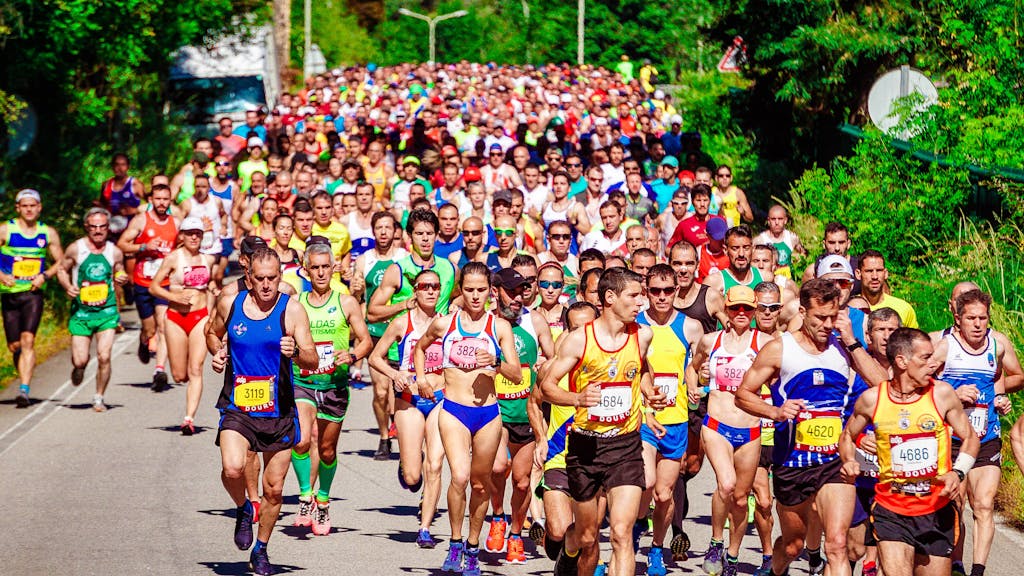What is a negative split?
The negative split method involves running the second half of the race faster than the first, and when executed correctly, it can lead to stronger finishes and a sense of accomplishment. In this article, we’ll explore the concept of negative splits and provide practical tips for pacing your next long distance road race to perfection. Other pacing strategies are of course possible!
Understanding Negative Splits
Negative splits refer to the practice of running each successive portion of a race faster than the previous one. There is plenty of science out there1 to explain how the build up of lactate in our bodies makes us feel sluggish so the sooner we hit the lactate threshold – essentially where our body is not able to deal with the lactate fast enough – the sooner we will fatigue. Setting out too fast in an event means we reach our lactate threshold earlier on and could lead to a slight – or even significant – drop off in our times per mile or kilometre as the race progresses.
In the context of a long distance running race (e.g. half marathon or marathon), this means starting at a slightly conservative pace and gradually increasing your speed as the race progresses. By doing so, you conserve energy early on, allowing you to finish strong with a burst of speed in the later miles.
The key to negative splits lies in pacing yourself appropriately and resisting the urge to start too fast. While it may seem counterintuitive to hold back in the beginning stages of a race, this conservative approach sets the stage for a strong and sustainable performance.
Benefits of Negative Splits

There are several benefits to adopting a negative splits strategy for your lon- distance road race:
1. Conservation of Energy: Starting at a moderate pace prevents early fatigue and conserves valuable energy for the latter stages of the race.
2. Reduced Risk of Burnout: By avoiding an overly aggressive start, you minimise the risk of hitting the proverbial “wall” and experiencing a significant drop in performance.
3. Strong Finish: With energy reserves intact, you can finish the race with a flourish and of course a smile on your face, accelerating in the final miles and passing competitors who may have started too fast and faded.
4. Psychological Boost: Overtaking runners in the latter stages of the race can provide a psychological boost, lifting your confidence and motivation.
(Potential) Drawbacks of Negative Splits
1. Leaving Too Much to Make Up: It is essential to be familiar with your average pace for the distance – you don’t want to leave yourself too much to do towards the latter stage of the event.
2. Panicking!: You may increase your stress levels inadvertently by becoming concerned that everyone is overtaking you. This is where your mental strength comes in – hold your nerve and trust the process!
3. Change in Terrain Profile: Negative splits can only really work when the terrain profile remains constant, ie. mostly flat. You will see changes in pace naturally for slight inclines and declines but for hilly / off road halfs or marathons, running by effort would seem to make more sense.
Practical Tips for Pacing with Negative Splits
Implementing negative splits requires careful planning and execution. Here are some practical tips to help you pace your long-distance running race effectively:
1. Know Your Pace: Familiarise yourself with your target pace per mile or kilometre based on your goal finish time. Make sure this finish time is realistic, not just a random time that you want to beat. This will serve as a guide during the race to ensure you stay on track.
2. Start Conservatively: Resist the temptation to sprint off the starting line. Begin at a comfortable pace that allows you to settle into a rhythm without exerting excessive effort. Don’t be put off by being overtaken by lots of people, or by the person dressed as a dinosaur or carrying a fridge on their back! This first part of the race will be slower than your race pace.
3. Focus on Even Effort: Instead of fixating solely on your current pace, focus on maintaining a consistent effort level throughout the race. This may mean adjusting your pace slightly based on factors such as terrain and weather conditions.
4. Monitor Your Split Times: Keep track of your split times at designated intervals, such as every couple of miles or every 5 kilometres. You could aim to run the middle section of the race at a consistent pace (ideally your actual race pace) or you may decide to keep increasing each section to run each successive split slightly faster than the previous one, gradually increasing your pace as you approach the finish line.This means the latter stage of the race will actually be slightly faster than your race pace.
5. Stay Mentally Engaged: Mental toughness is crucial for executing negative splits. Stay focused, maintain a positive mindset, and draw upon mental strategies such as visualisation and positive self-talk to keep yourself motivated.
6. Practice Negative Splits in Training: Learn how to monitor your pace on your sports watch. Incorporate negative splits into your training runs to familiarise yourself with the pacing strategy and build confidence in your ability to execute it on race day.
Conclusion
Pacing a long-distance running race such as a half marathon or marathon with negative splits requires discipline, patience, and a strategic approach. By starting conservatively, gradually increasing your speed, and finishing strong, you can unlock your full potential and achieve your race goals. Remember to trust the process, listen to your body, and stay mentally resilient throughout the race. With the right preparation and mindset, mastering the art of negative splits can lead to a rewarding and memorable half marathon or marathon experience. So lace up your shoes, embrace the challenge, and let the pursuit of negative splits propel you to new heights of performance and accomplishment.
If you’re looking to improve your running technique, stamina and pacing, why not join one of our weekly run sessions, or one of our fortnightly social runs? We can also offer 1:1 coaching with gait / running technique analysis.


